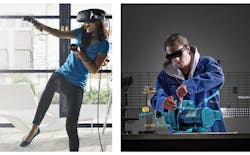This file type includes high-resolution graphics and schematics when applicable.
When “augmented reality” (AR) is mentioned, a lot of people still think of Tony Stark swiping through virtual blueprints in Iron Man, and now, Pokémon Go. Yes, that’s Hollywood and gaming, but AR is already being used today to transform enterprises across the world. However, is what you know about AR really true?
To find out, let’s explore 11 of the most common myths associated with AR technology.
1. Augmented reality (AR) and virtual reality (VR) are the same thing.
Though related, AR and VR are completely different experiences. AR aims to enhance a user’s real-world experience by placing new content within that real-world experience. VR, on the other hand, completely obscures one’s vision (and often their hearing), immersing the user in an entirely new environment.
About the only thing similar between AR and VR is that both enhance a user’s experience with 3D content. The applicable use cases, technologies, and challenges are vastly different.
For instance, the AR and VR experiences are quite the contrast. VR requires a dedicated headset, such as an Oculus Rift or HTC Vive, which must be tethered to a powerful computer because of the computational requirements. Because mobility is limited, and the user’s vision is obscured, a user is usually restricted to a single pre-mapped room to avoid bumping into things.
With AR, content is overlaid on top of the user’s real-world experience, allowing users to walk around their entire environment with no restrictions. AR can also be experienced in a variety of ways, whether with head-worn devices, such as the ODG R7 or Microsoft HoloLens, or in a simplified fashion, such as on a phone or tablet (Fig. 1).
2. AR is limited to kitschy marketing/games like Pokémon Go.
Absolutely not! Although we’ve seen some interesting AR experiences in marketing and gaming, AR’s true potential lies in the enterprise. AR is being successfully applied in a variety of heavy industries, including manufacturing, mining, oil and gas, automotive, field service, and construction.
For a real-life example, check out the video below, which shows how Scope AR teamed up with Martin Bros., a Los Angeles drywall company, to leverage Scope AR’s technology and HoloLens to construct the framing for a room in augmented reality without the use of plans or documents:
Additional compelling use cases include inspection and quality assurance, where you can overlay planned models over the as-built end product, which can easily highlight differences visually.
In fact, AR is nothing short of a new way to interact with the power of computing. It will provide the ability to visualize data in ways never before seen, and provide contextually aware information in a convenient and consumable format. Imagine visualizing intuitive visual instructions to show someone how to change the oil in their car, or see the temperature gradient in an engine’s radiator, or visually see the wear-and-tear on a tire. AR will make all of these things possible.
3. AR is like Iron Man or the Terminator.
Hollywood is often at the forefront of imaging technologies that aren’t yet invented. In fact, tablet-like devices were very common in Star Trek, and they even envisioned Google Glass-like AR devices in a few episodes. Similarly, the Terminator experienced reality through a very AR-like heads-up display, and Tony Stark was able to visualize data in 3D in AR in a similar way (Fig. 2).
What these movies got right about AR is that they portrayed user interfaces, or in other words, ways in which we as humans interact with machines and data. In the end, that’s what augmented reality is about: Presenting information in a way that’s more natural to mere mortals than the typical two-dimensional experience. And that’s what’s so exciting about AR...it’s a new paradigm for human-machine computing.
For the past 30 or so years, we’ve been able to harness the power of computers to do some amazing things, e.g., e-commerce, social media, analytics, democratization of information, etc. But a large segment of the population has largely been left out of this revolution, and that’s the people who work with their hands and their eyes every day. AR has the potential to allow these workers to have the same power applied to revolutionize their industries, and that’s an amazing opportunity.
4. It’s not useful.
Many people have only been exposed to AR through silly games or advertisements. For this reason, many people believe AR isn’t useful and can be used only for cheesy visualization purposes.
On the contrary, AR is incredibly useful. The aforementioned “new user interface” technology will allow people to visualize and interact with data like they never have before. From AR education and training to maintenance instructions, to real-time collaborative field service, to quality assurance, to inspections, to architectural previsualization, to construction guidance—the number of use cases where augmented reality is being applied is staggering. And, AR tools can automatically collect data and provide actionable insights, resulting in improved comprehension, efficiency, and knowledge retention for enterprises.
For instance, check out the video below (source: Pepsi Max), where Pepsi Max surprises commuters with an “unbelievable” augmented reality experience at a bus shelter on New Oxford Street in London:
5. AR is hard to make/expensive.
It’s true that a few years ago, creating AR experiences was difficult and time-consuming, and the experiences were usually built as one-offs and weren’t scalable. But just as the mobile-app economy exploded, once developers had a template to code and develop their own apps, the same is now true for AR.
New platforms are allowing for the same templated, simplistic development for smart instruction AR tools. Thus, any organization can harness the power of AR through a simple drag-and-drop feature with no coding required. In addition, hardware manufacturers are improving the core technologies within mobile devices that drive AR, helping drive its proliferation.
6. It’s a gimmick; it’s not real.
For a long time, AR had a bad reputation for being exaggerated, and many companies released slickly produced videos showing what was “possible” with AR, when in fact these videos weren’t real at all. Case in point, this BMW video (source: V431) from a few years back got a lot of people excited about what was “possible”:
We’ve come a long way since then, and AR experiences are much more evolved and useful than magazine ads.
8. Only big companies can do it.
Prior to the democratization of AR-creation technologies, AR was time-consuming and expensive (see Myth #5 above), leaving it to the domain of the giant companies like Boeing and BMW. However, these days, with tools that allow for rapid content creation, AR is being used by companies of all sizes for things like AR-enabled remote assistance, or simple installation and assembly instructions.
Among the examples are a small company that manufactures radiators uses AR to deliver final assembly and installation instructions to customers (reducing onsite errors and support calls); a small oilfield operator employs AR for training on proper maintenance techniques; and a small construction contractor uses it for guidance in framing. These small companies are realizing huge gains in productivity and efficiency in their operations, which is particularly critical in small- and medium-sized operations.
9. It’s not ready for a mainstream audience.
Pokémon Go, although basic, certainly got the attention of the mainstream public. However, what it really did was open the world’s eyes to the potential that this technology could have for the future. This year has, in my opinion, been an inflection point as far as advances in hardware and wider-spread acceptance are concerned. We’re seeing major players investing billions of dollars into the space and real, usable apps getting penetration, all of which are good indicators that AR is on the move toward mainstream.
10. It’s not ready for prime time.
Although it might be a few years before becoming commonplace, AR tools are ready to deploy today and are already being used to solve a wide array of problems. In addition to the use cases mentioned above, there are literally dozens more use cases that are starting to deploy AR: IoT-enabled data visualization and intelligent work instruction guidance, AR-enabled remote collaboration, real-time manufacturing work instructions, and inspection overlays, to name a few.
CIOs from every company should be looking toward a comprehensive strategy for how they will incorporate AR into their company’s plans. The companies that adopt these technologies today will have a major advantage over their competitors down the line.
11. You need AR glasses.
Although remote and field workers would prefer a hands-free experience, it’s entirely viable to deploy solutions on tablets and phones. Scope AR’s product, Remote AR, is being used by thousands of workers to improve productivity, the majority of them on phones and tablets. With better hardware on the horizon and coming in at a lower price point, AR glasses are sure to make headway in the enterprise in a short time frame. As for consumers, after the Google Glass debacle, probably not as soon.





